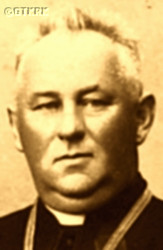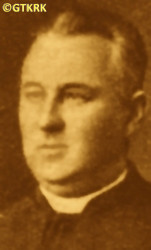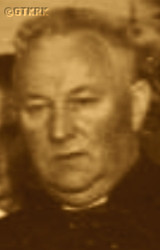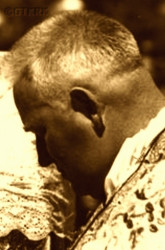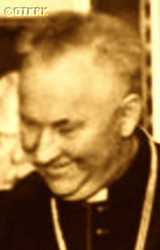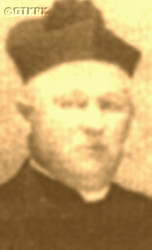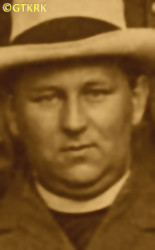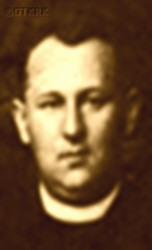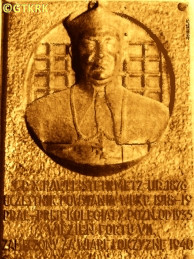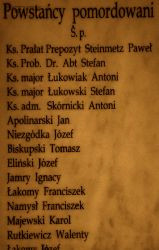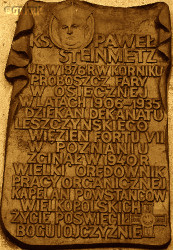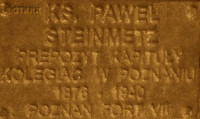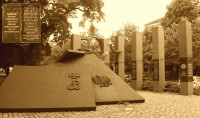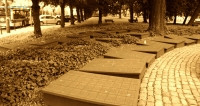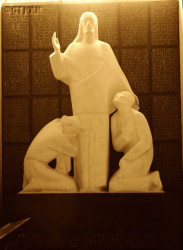Roman Catholic
St Sigismund parish
05-507 Słomczyn
85 Wiślana Str.
Konstancin deanery
Warsaw archdiocese, Poland
full list:
displayClick to display full list

searchClick to search full list by categories
wyświetlKliknij by wyświetlić pełną listę po polsku

szukajKliknij by przeszukać listę wg kategorii po polsku

Martyrology of the clergy — Poland
XX century (1914 – 1989)
personal data
surname
STEINMETZ
surname
versions/aliases
STAJMEC
forename(s)
Paul (pl. Paweł)
function
diocesan priest
creed
Latin (Roman Catholic) Church RCmore on
en.wikipedia.org
[access: 2014.09.21]
diocese / province
Gniezno and Poznań archdiocese (aeque principaliter)more on
www.archpoznan.pl
[access: 2012.11.23]
RC Military Ordinariate of Polandmore on
en.wikipedia.org
[access: 2014.12.20]
honorary titles
pontifical prelatemore on
en.wikipedia.org
[access: 2014.11.14]
(13.05.1935)
Prelate‐provost (Lat. praelati‐praepositus)more on
en.wikipedia.org
[access: 2015.03.01]
(05.06.1935 – , Our Lady of Perpetual Help, St Mary Magdalene and St Stanislav the Bishop and Martyr RC collegiate church, Poznańtoday: Poznań city pov., Greater Poland voiv., Poland
more on
en.wikipedia.org
[access: 2021.07.18])
„Polonia Restituta” Cross — 4th Class, Officer'smore on
en.wikipedia.org
[access: 2019.04.16]
(03.05.1928)
„Medal of Independence”more on
en.wikipedia.org
[access: 2019.02.02]
(16.03.1933)
„Cross of Valour”more on
en.wikipedia.org
[access: 2019.04.16]
Gold „Cross of Merit”more on
en.wikipedia.org
[access: 2019.04.16]
(24.05.1937)
Commemorative Medal for War of 1918–21more on
pl.wikipedia.org
[access: 2019.10.13]
„For Valor” Crossmore on
pl.wikipedia.org
[access: 2025.08.19]
„Gen. Haller's Sword” badgemore on
pl.wikipedia.org
[access: 2025.08.19]
date and place
of death
01.1940

KL Posenconcentration camp
today: Poznań, Poznań city pov., Greater Poland voiv., Poland
more on
en.wikipedia.org
[access: 2022.01.09]
alt. dates and places
of death
21‑23.01.1940
forest n. Zbąszyńtoday: Zbąszyń gm., Nowy Tomyśl pov., Greater Poland voiv., Poland
more on
en.wikipedia.org
[access: 2021.06.20]
details of death
While studying at the Germ. Königliche Friedrich–Wilhelms–Gymnasium (Eng. Friedrich William Royal Gymnasium) in Poznań and at the Germ. Königliche Gymnasium (Eng. Royal Gymnasium) in Wschowa, a member of the clandestine Polish self‐education Thomas Zan Society — in Wschowa was the president of the school chapter.
In 1908, 1911 and 1913 participant of pre‐election rallies in the Germ. Kreis Lissa (Eng. Leszno County), in the Prussian part of partitioned Poland, i.e. the Germ. Provinz Posen (Eng. Poznań Province), supporting Polish candidates to the Germ. Preußischer Landtag (Eng. Prussian National Parliament) — elections were held in 1908 and 1913 — and to the Germ. Reichstag (Eng. Reich Parliament) of the German Empire — elections were held in 1903, 1907 and 1912.
In 1912 convened clandestine meetings due to the intensification of anti‐Polish activities of the Prussian authorities.
During World War I 1914‐1918 chaplain of the lazaretto — military hospital — organized by the Germans in the Sisters of St Elizabeth CSSE St Joseph House in Osieczna.
After the abdication on 09.11.1918 of the German Emperor William II Hohenzollern; after the signing on 11.11.1918 by the Allies and the Germans, in the staff wagon in Compiègne, at the headquarters of French Marshal Ferdinand Foch, of the armistice and ceasefire — which de facto meant the end of World War I; and also after the handover on 11.11.1918 by the Regency Council – operating in the so‐called Germ. Königreich Polen (Eng. Polish Kingdom) occupied by the Central Powers (Germany and Austria–Hungary) — of supreme command over the army to Brigadier Joseph Piłsudski and his appointment as Commander‐in‐Chief of the Polish Army, which de facto meant the rebirth of the Polish state, encompassing however only the Germ. Königreich Polen, i.e. the Polish territory under Russian rule until 1915, but excluding the lands of the Prussian partition; Greater Poland — as the Prussian Germ. Provinz Posen (Eng. Poznań Province) — was still formally part of the German state. And his Osieczna was a town in Greater Poland, then part of the Germ. Kreis Lissa (Eng. Leszno county). The county seat, Leszno, c. 9 km south‐west of Osieczna, was a strong German centre, maintaining contact — especially by rail — with the large, German city of Wrocław in the Germ. Provinz Schlesien (Eng. Province of Silesia). And it was in Leszno that the Germ. Soldatenrat (Eng. Soldiers' Council) RŻ was established on 10.11.1918, whose members were German soldiers stationed in the local garrison. On 11.11.1918, the Germ. Arbeiterrat (Eng. Workers' Council) RR was established, which included several Poles. Two days later, in the military hospital in Osieczna, where was a chaplain, a branch of Leszno RŻ was established, and a day later local RR, of which became chairman. A fundamental contradiction in the aspirations of the councils from Leszno and Osieczna quickly became apparent — while the councils from Leszno recognized the supremacy of the Workers' and Soldiers' Council RR‐Ż from Wrocław, the RR from Osieczna looked up to Poznań. That is why on 20.11.1918 — at the appeal of the Polish Supreme People's Council from Poznań, established on the basis of the former clandestine Inter‐Party Committee, which supported the Allies during the war (which was, of course, a betrayal of the German state) — the County People's Council PRL was established in Leszno, based on the Clandestine National Committee, established on 10.10.1918, which had been operating until then and represented Polish interests. Became its member. On 30.11.1918, a local People's Council was established in Osieczna, of which became the chairman. Its meetings were held in the rectory. Publicly demanded the introduction of the Polish language in schools and the expulsion of Germans from the administration. On 13.12.1918, the Council resolved that the only legitimate Polish authority in the district was the PRL in Leszno.
Prob. seeing the growing German–Polish rift, and recognizing that the only way for Greater Poland to join Poland was an uprising, on 12.12.1918 reactivated the „Falcon” Gymnastic Society in Osieczna, whose members included, among others, Poles demobilized from the German army. Under the guise of training, future insurgent cadres were formed there. In his apartment — and in the former Franciscan monastery, where the House for Retired Priests was located, of which was the director, and to which there was a secret passage directly from the parish church — meetings of the „Falcon” command were held.
On 27.12.1918, the Greater Poland Uprising broke out in Poznań. Already on 29.12.1918, called c. 300 insurgent soldiers from his parish to a thanksgiving service for their safe return from the war, after which took an oath to defend „faith and homeland until the last drop of blood”. Almost immediately, the Polish–German front was established along the line between Osieczna and Leszno. In Leszno itself, on 04.01.1919, the Germans searched the premises of all members of the PRL in the city, and a few days later arrested and interned them. In Osieczna, however, due to the lack of weapons, the Poles did not take any active action until the insurgent units entered it on 07.01.1919. Till then already taken a loan from the bank in the amount of 5,000 marks, from which financed the insurgent unit that was being formed from then on and the Red Cross Society that was established on 02.01.1919, of which became the president and which organised the insurgent hospital. The insurgent units defending the section of the front running through the district adopted the name of the „Leszno” Group ‐ formally, the name was adopted on 16.01.1919. Became its chaplain, and in the monastery premises in Osieczna, which were under his supervision, meetings of its staff and command were held. On 08.01.1919 the Germans, leaving Leszno, began the offensive — they had already brought on 06.01.1919 a German armoured train to the neighbouring village of Kąkolewo. And on 10.01.1919 attempted to capture Osieczna, but without success. That same day, the insurgents forced the German mayor of Osieczna to resign. The next day, the Germans renewed their attack on Osieczna — with larger forces, significantly superior to the insurgents' armaments. The battle, which went down in history as the „Battle of Windmills”, ended with a daring Polish bayonet charge in an open field, repelling the attack —despite the Germans using poison gas — and the withdrawal of the enemy. On 27.01.1920 took the oath from a new insurgent company formed in Osieczna...
The Uprising ended on 16.02.1919 with an armistice in Trier, enforced by the victorious Entente states, under which the Polish insurgent Greater Poland Army was recognized as an allied army and a border was set, the crossing of which „German troops were forbidden” to cross, leaving a large part of Greater Poland outside their influence. Leszno remained however on the German side of the demarcation line. On 06.03.1919 the „Leszno” Group, by order of the Supreme Commander of the Greater Poland Army, Gen. Joseph Dowbor–Muśnicki, was renamed the 6th Greater Poland Rifle Regiment. From 25.03.1919 was its chaplain. Contributed to the establishment of the first Non‐Commissioned Officers' School in Greater Poland in the former Franciscan monastery. There was a lack of officer cadre in the insurgent ranks — which was not surprising, since during the Prussian rule the Germans had not allowed even a single university to be opened in Greater Poland! Taught Polish history and literature there. The first course lasted till 06.1919 and was attended by 76 candidates.
On 28.06.1919 the Treaty of Versailles was signed, formally ending World War I. It formally awarded Greater Poland to Poland, including the Germ. Kreis Lissa with Osieczna and Leszno. On 06.08.1919 the 6th Regiment was moved to Kościan, and later to the Western Front, and then the Northern Front, in the vicinity of Żnin, of the Greater Poland Army. Ceased then to ministered as its chaplain. On 10.01.1920, after ratifications, the provisions of the Treaty of Versailles came into force — Greater Poland, together with Osieczna and Leszno, was incorporated into Poland.
After German and Russian invasion of Poland in 09.1939 and start of the World War II, after start of German occupation, arrested on 10.10.1939 by the Germans (according to other sources on 11/12.09.1939, right after the capture of Poznań, where ministered, by the Germans).
Jailed in Germ. Geheime Staatspolizei (Eng. Secret State Police), i.e. Gestapo, prison at Młyńska Str. in Poznań and next in IL Bischofsfelden transit camp in Kazimierz Biskupi.
From there moved to Konin prison and treated as a hostage — designed to ensure obedience of all Catholic priests detained in Kazimierz Biskupi camp (according to other sources taken to IL Long internment camp in Ląd on Warta).
On 10.12.1939 (or 14.12.1939) released and deported to Germ. Generalgouvernement (Eng. General Governorate).
Poznań German Gestapo started however to search for him for participation in Greater Poland Uprising and soon, on 06.01.1940, in Poręba village n. Tarnów arrested again by the Germans.
Brought back to Poznań and held in KL Posen (Fort VII) concentration camp.
There tortured and prob. murdered — possibly torn and bitten by the dogs.
alt. details of death
According to some witnesses driven out of KL Posen (Fort VII) together with group of convicts bound together by a wire in Zbąszyń direction and there, in local forests, murdered.
It is worth noticing that in 01.1940 Germans murdered c. 2,000 KL Posen prisoners on the shores of Rusałka lake in Poznań (in Golęcin forests).
Also: according to some sources was deported to Germ. Generalgouvernement earlier, on 04.12.1939, and there escaped from transport and moved towards Kielce
cause of death
murder
perpetrators
Germans
sites and events
KL PosenClick to display the description, GeneralgouvernementClick to display the description, Deportations from Reichsgau WarthelandClick to display the description, Collective responsibility („Hostages”)Click to display the description, KoninClick to display the description, IL BischofsfeldenClick to display the description, IL LondClick to display the description, Reichsgau WarthelandClick to display the description, UH PosenClick to display the description, «Intelligenzaktion»Click to display the description, Ribbentrop‐MolotovClick to display the description, Pius XI's encyclicalsClick to display the description, Greater Poland UprisingClick to display the description, Thomas Zan SocietiesClick to display the description
date and place
of birth
13.01.1876Birth certification on:
photos.szukajwarchiwach.gov.pl
[access: 2025.08.19]

Kórniktoday: Kórnik gm., Poznań pov., Greater Poland voiv., Poland
more on
en.wikipedia.org
[access: 2021.07.15]
parents
STAJMEC Paul
🞲 ?, ? — 🕆 ?, ?

WARZECHA Florentine
🞲 ?, ? — 🕆 ?, ?
presbyter (holy orders)
ordination
15.12.1901

Gnieznotoday: Gniezno urban gm., Gniezno pov., Greater Poland voiv., Poland
more on
en.wikipedia.org
[access: 2021.12.18]
positions held
1939 – 1940
resident — Poręba Radlnatoday: Tarnów gm., Tarnów pov., Lesser Poland voiv., Poland
more on
en.wikipedia.org
[access: 2021.04.01] ⋄ St Peter and St Paul the Apostles RC parish ⋄ Tarnówtoday: Tarnów city pov., Lesser Poland voiv., Poland
more on
en.wikipedia.org
[access: 2021.06.07] RC deanery
05.06.1935 – 1939
Prelate‐provost (Lat. praelati‐praepositus) — Poznańtoday: Poznań city pov., Greater Poland voiv., Poland
more on
en.wikipedia.org
[access: 2021.07.18] ⋄ Collegiate Chapter ⋄ St Mary Magdalene RC collegiate church
1935 – 1939
parish priest — Poznańtoday: Poznań city pov., Greater Poland voiv., Poland
more on
en.wikipedia.org
[access: 2021.07.18] ⋄ St Mary Magdalene RC collegiate parish (main parish) ⋄ Poznańtoday: Poznań city pov., Greater Poland voiv., Poland
more on
en.wikipedia.org
[access: 2021.07.18] RC deanery — also: 1935‐1939 member of the Lat. „Consilium a Vigilantiae” (Eng. „Committee on Morals”) at the Metropolitan Curia; 1935‐1939 treasurer general of the archdiocesan Pontifical Institute of St Peter the Apostle at the Metropolitan Curia; 1935‐1939 deputat i.e. Archbishop's delegate on the Archbishop Seminary's Properties Board in Poznań; 1935‐1939 Archbishop's inspector at church care institutes; c. 1938‐1939 Archbishop's delegate in the Archdiocesan „Caritas” Institute; c. 1938‐1939 president of the Temperance Brotherhoods' Union; c. 1938‐1939 president of the archdiocesan Pension Fund for Priests Institute; 1938‐1939 president of the Main Board of the Association of Greater Poland Insurgents; 1935‐1939 inspector of religious education in primary schools in the Poznań 4th district; church assistant at the Charles Marcinkowski Scientific Aid Society
1920 – 1935
dean — Lesznotoday: Leszno city pov., Greater Poland voiv., Poland
more on
en.wikipedia.org
[access: 2021.07.18] RC deanery — initially deputy dean
1906 – 1935
parish priest — Osiecznatoday: Osieczna gm., Leszno pov., Greater Poland voiv., Poland
more on
en.wikipedia.org
[access: 2021.07.18] ⋄ Holy Trinity RC parish ⋄ Śmigiel / Lesznodeanery names/seats
today: Greater Poland voiv., Poland RC deanery — also: c. 1929‐1935 member of the Lat. „Consilium a Vigilantiae” (Eng. „Committee on Morals”) at the Metropolitan Curia; 1929‐1935 Archbishop's delegate at secondary levels i.e. matura exams in teachers' seminaries for Leszno county; 1931‐1935 deputat i.e. Archbishop's delegate on the Archbishop Seminary's Properties Board in Poznań; 1932‐1935 Archbishop's inspector at church care institutes; c. 1929‐1935 inspector of religious education in primary schools in Leszno county; c. 1911‐1927 director of the Retired Priests House in the former Franciscan monastery; co‐founder, vice‐president and chairman of the supervisory board of the „Leszno Printing House” cooperative; chairman of the Board of the 8th District of the Union of Insurgents and Soldiers in Leszno; after 1919 chairman of the People's Reading Rooms Society in Leszno County; 1906‐1911 and 1915‐1919 member of the Board of the Municipal Savings Bank in Leszno County; member of the District Assembly in Leszno; on c. 1907 co‐founder and board member of the Pl. „Rolnik” (Eng. „Farmer”) Company; 1907‐1910 chairman of Farmers' Group in Osieczna; from 1907 president of the Catholic Society of Polish Workers
1934
administrator — Święciechowatoday: Święciechowa gm., Leszno pov., Greater Poland voiv., Poland
more on
en.wikipedia.org
[access: 2021.07.18] ⋄ St James the Great the Apostle RC parish ⋄ Lesznotoday: Leszno city pov., Greater Poland voiv., Poland
more on
en.wikipedia.org
[access: 2021.07.18] RC deanery — acting („ad interim”)
1923 – 1924
administrator — Zbarzewotoday: Włoszakowice gm., Leszno pov., Greater Poland voiv., Poland
more on
en.wikipedia.org
[access: 2021.07.18] ⋄ Nativity of the Blessed Virgin Mary RC parish ⋄ Lesznotoday: Leszno city pov., Greater Poland voiv., Poland
more on
en.wikipedia.org
[access: 2021.07.18] RC deanery — acting („ad interim”)
c. 1919
administrator — Kąkolewotoday: Osieczna gm., Leszno pov., Greater Poland voiv., Poland
more on
en.wikipedia.org
[access: 2021.07.18] ⋄ All the Saints RC parish ⋄ Lesznotoday: Leszno city pov., Greater Poland voiv., Poland
more on
en.wikipedia.org
[access: 2021.07.18] RC deanery — acting („ad interim”)
01.1919 – 08.1919
RC military chaplain — Osiecznatoday: Osieczna gm., Leszno pov., Greater Poland voiv., Poland
more on
en.wikipedia.org
[access: 2021.07.18] ⋄ 6th Greater Poland Riflemen Regiment, Greater Poland Army (i.e. Polish Armed Forces in the former Prussian Partition), Polish Armed Forces — till 25.03.1919 known as „Leszno” Group
c. 1915
chaplain — (Silesia territory)today: Poland
more on
en.wikipedia.org
[access: 2023.11.24] — among Polish prisoners of war — i.a. brought and sent them Polish newspapers and brochures
c. 1908
missionary — (Germany territory)today: Germany
more on
en.wikipedia.org
[access: 2022.08.05] ⋄ Polish emigration centers — acting („ad interim”)
1906
administrator — Osiecznatoday: Osieczna gm., Leszno pov., Greater Poland voiv., Poland
more on
en.wikipedia.org
[access: 2021.07.18] ⋄ Holy Trinity RC parish ⋄ Śmigieltoday: Śmigiel gm., Kościan pov., Greater Poland voiv., Poland
more on
en.wikipedia.org
[access: 2021.07.18] RC deanery
1902 – 1906
vicar — Lesznotoday: Leszno city pov., Greater Poland voiv., Poland
more on
en.wikipedia.org
[access: 2021.07.18] ⋄ St Nicholas the Bishop and Confessor RC parish ⋄ Lesznotoday: Leszno city pov., Greater Poland voiv., Poland
more on
en.wikipedia.org
[access: 2021.07.18] RC deanery — also: prefect at the Germ. Königliches Comenius–Gymnasium (Eng. Royal Amos Comenius Gymnasium)
till 1901
student — Gnieznotoday: Gniezno urban gm., Gniezno pov., Greater Poland voiv., Poland
more on
en.wikipedia.org
[access: 2021.12.18] ⋄ philosophy and theology, Archbishop's Practical Theological Seminary (Lat. Seminarium Clericorum Practicum)
from 1898
student — Poznańtoday: Poznań city pov., Greater Poland voiv., Poland
more on
en.wikipedia.org
[access: 2021.07.18] ⋄ philosophy and theology, Archbishop's Theological Seminary (Collegium Leoninum)
1908 – 1939
membership — Poznańtoday: Poznań city pov., Greater Poland voiv., Poland
more on
en.wikipedia.org
[access: 2021.07.18] ⋄ Friends of Sciences Society
others related
in death
CEGIEŁClick to display biography Thaddeus Vladimir Cornelius, FLACHClick to display biography Julian, GRAMLEWICZClick to display biography Edward, HARASYMOWICZClick to display biography Vincent, JANICKIClick to display biography Stanislav, JANKOWSKIClick to display biography Alphonse, KUBIKClick to display biography Alexander, ŁUKOWSKIClick to display biography Steven, MAŁECKIClick to display biography Stanislav, MANITIUSClick to display biography Gustav, MIROCHNAClick to display biography Steven Marian (Fr Julian), MZYKClick to display biography Louis, NIEDBAŁClick to display biography Anthony Marian, NOWAKClick to display biography Francis Joseph, PIOTROWSKIClick to display biography Ignatius, POPRAWSKIClick to display biography Marian, SĘKIEWICZClick to display biography Mauritius Vaclav, SZREYBROWSKIClick to display biography Casimir, TYMAClick to display biography Joseph, WIŚNIEWSKAClick to display biography Mary, WOŹNIAKClick to display biography Albin, ADAMSKIClick to display biography Ignatius, BAJEROWICZClick to display biography Adalbert Stanislav, BINEKClick to display biography Silvester, DĄBROWSKIClick to display biography Steven, DUDZIŃSKIClick to display biography Stanislav, GIEBUROWSKIClick to display biography Vaclav Casimir, GRASZYŃSKIClick to display biography Alphonse, HAŁASClick to display biography Anthony, HEYDUCKIClick to display biography Ceslav, KANIEWSKIClick to display biography Zbigniew, KAŹMIERSKIClick to display biography Boleslav, KRUSZKAClick to display biography Steven, MICHALSKIClick to display biography Stanislav, NIKLEWICZClick to display biography Ceslav Vladislav, PACEWICZClick to display biography Vaclav, PANEWICZClick to display biography Roman, PANKOWSKIClick to display biography Peter Romualdo Casimir, ROSENBERGClick to display biography Louis, SOŁTYSIŃSKIClick to display biography Romualdo, ŚPIKOWSKIClick to display biography Marian, TACZAKClick to display biography Theodore, THEINERTClick to display biography Roman Sigismund, WIERZCHACZEWSKIClick to display biography Maximilian Francis Ambrose, WOLSKIClick to display biography Francis, ZALEWSKIClick to display biography Edward Victor, ZWOLSKIClick to display biography Steven, SZUKALSKIClick to display biography John Wladysław
sites and events
descriptions
KL Posen: German Posen — Fort VII — camp founded in c. 10.10.1939 in Poznań till mid of 11.1939 operated formally as Germ. Konzentrationslager (Eng. concentration camp) KL Posen, and this term is used throughout the White Book, also later periods. It was first such a concentration camp set up by the Germans on Polish territory — in case of Greater Poland (Wielkopolska) directly incorporated into German Reich. In 10.1939 in KL Posen for the first time Germans used gas to murder civilian population, in particular patients of local psychiatric hospitals. From 11.1939 the camp operated as German political police Gestapo prison and transit camp (Germ. Übergangslager), prior to sending off to concentration camps, such as KL Dachau or KL Auschwitz. In 28.05.1941 the camp was rebranded as police jail and slave labour corrective camp (Germ. Arbeitserziehungslager). At its peak up to 7‐9 executions were carried in the camp per day, there were mass hangings of the prisoners and some of them were led out to be murdered elsewhere, outside of the camp. Altogether in KL Posen Germans exterminated approx. 20,000 inhabitants of Greater Poland (Wielkopolska) region, including many representatives of Polish intelligentsia, patients and staff of psychiatric hospitals and dozen or so Polish priests. Hundreds of priests were held there temporarily prior to transport to other concentration camps, mainly KL Dachau. From 03.1943 the camp had been transformed into an industrial complex (from 25.04.1944 — Telefunken factory manufacturing radios for submarines and aircrafts). (more on: www.wmn.poznan.plClick to attempt to display webpage
[access: 2019.02.02], en.wikipedia.orgClick to attempt to display webpage
[access: 2013.12.27])
Generalgouvernement: After the Polish defeat in the 09.1939 campaign, which was the result of the Ribbentrop‐Molotov Pact and constituted the first stage of World War II, and the beginning of German occupation in part of Poland (in the other, eastern part of Poland, the Russian occupation began), the Germans divided the occupied Polish territory into five main regions. In two of them new German provinces were created, two other were incorporated into other provinces. However, the fifth part was treated separately, and in a political sense it was supposed to recreate the German idea from 1915 (during World War I, after the defeat of the Russians in the Battle of Gorlice in 05.1915) of creating a Polish enclave within Germany. Illegal in the sense of international law, i.e. Hague Convention, and public law, managed by the Germans according to separate laws — especially established for the Polish Germ. Untermenschen (Eng. subhumans) — till the Russian offensive in 1945 it constituted part of the Germ. Großdeutschland (Eng. Greater Germany). Till 31.07.1940 formally called Germ. Generalgouvernement für die besetzten polnischen Gebiete (Eng. General Government for the occupied Polish lands) — later simply Germ. Generalgouvernement (Eng. General Governorate), as in the years 1915‐1918. From 07.1941, i.e. after the German attack on 22.06.1941 against the erstwhile ally, the Russians, it also included the Galicia district, i.e. the Polish pre‐war south‐eastern voivodeships. A special criminal law was enacted and applied to Poles and Jews, allowing for the arbitrary administration of the death penalty regardless of the age of the „perpetrator”, and sanctioning the use of collective responsibility. After the end of the military conflict of the World War UU, the government of the Germ. Generalgouvernement was recognized as a criminal organization, and its leader, governor Hans Frank, guilty of war crimes and crimes against humanity and executed. (more on: en.wikipedia.orgClick to attempt to display webpage
[access: 2024.12.13])
Deportations from Reichsgau Wartheland: After defeating Poland in 1939 a new province was created in Germany, Germ. Reichsgau Wartheland (Eng. Warta German Region) and defined as „indigenous German”, although in 1939 Germans constituted less than 10% of the total population there. In the same 1939, the national‐socialist leader of Germany, Adolf Hitler, announced the need to move Germans from the East to the Reich, mainly to the Germ. Reichsgau Wartheland. Another German leader, Robert Ley, stated, „In 50 years there will be a thriving German country where there will be neither a Pole nor a Jew! If someone asks me where they will be, I will answer: I don't know. In Palestine or in the Sahara desert, I don't care. But German people will live here!” Deportations began. By the end of 1939, c. 80 railway transports were sent to the Germ. Generalgouvernement (Eng. General Governorate) — a total of 87,883 people, mainly Poles and Jews. By 03.1941, over 280,000 people had been displaced. The deported had the right to take with them 12‐30 kg per person. They were given half an hour to pack. Over 60,000 Germans from Estonia, Latvia, Finland, later from other regions, were brought in to replace them. In 1941, c. 70,000 remaining Jewsa were displaced. (more on: pl.wikipedia.orgClick to attempt to display webpage
[access: 2022.11.20])
Collective responsibility („Hostages”): A criminal practice implemented by the Germans in the occupied territories of Poland, applied from the very first day of World War II. At its core was an appointment and public announcement of a list of names of selected people whose lives depended on absolute compliance with German orders. Any violation of these ordinances, by any person, regardless of the circumstances, resulted in the murder of the designated „hostages”. In the first days of the war and occupation, it was used i.a. by the German Wehrmacht army to prevent acts of continuation of the defense by the Poles. Later, especially in the German‐run General Governorate, it was part of the official policy of the occupation authorities — collective responsibility for any acts of resistance to the occupier's practices. For the life of one German, even if death was due to customary reasons, the Germans carried out executions from a dozen to even a hundred Poles previously designated as „hostages”.
Konin: The prison founded by the Russians during the partitions of Poland, right after the January Uprising of 1863‐1864. The Russians detained and murdered there, among others the leader of the uprising in Konin, a Capuchin monk, Fr Maximilian Tarejwa. In 09.1939, after the start of World War II, the Germans took it over and used it as a prison and a detention center. Many Poles were held there — incl. hostages, who were later shot on 10.11.1939 in the Jewish cemetery. C. 180‐200 people were held in 24 cells (12 in the basement and 12 on the ground floor) at any one time. Together, several thousand Poles passed through the prison. After the end of hostilities of the World War II and the beginning of the Russian occupation, in the years 1945‐1956 the Commie‐Nazi authorities of the People's Republic of Poland prl murdered at least 10 people in prison. (more on: lajt.lm.plClick to attempt to display webpage
[access: 2010.08.11])
IL Bischofsfelden: The Gestapo District Office in Poznań issued on 13.12.1939 executive instruction Ref. IIB No. 406/39 Tgb. No. 3045/39, ordering: „Based on the regulation of the Germ. Höherer SS‐ und Polizeiführer (Eng. Higher Commander of the SS and Police) [of the German province of Warthegau (Eng. Greater Poland)] of 12.11.1939 [SS‐Gruppenführer Wilhelm Koppe], apart from Poles and Jews, also Catholic clergy will be expelled. Action against this group of people should be carried out in such a way that internment and transport are separate […] C. 80% of Catholic clergy are expected to be expelled. The selection based on political threat posed. Internees cannot be placed in regular transit camps due to the possibility of international protest. Catholic clergy should be interned in men's monasteries and held there till mass transportation out”. And so in the Missionary of the Holy Family MSF monastery, in Kazimierz Biskupi village, near Konin, the Germans set up the IL Bischofsfelden transit Germ. „Internierungslager” (Eng. „Internment camp”) for altogether 42 Polish Catholic priests, mainly from Greater Poland (Wielkopolski) — activists of Catholic organizations, canons of the Poznań cathedral chapter, Dominican and Conventual Franciscan friars from Poznań. The camp operated from 09.11.1939 to 26.08.1940. Some of the priests were released by Germans, the rest being transported to German concentration camps, where 8 of them perished. After the liquidation of the camp, the Germans converted the church and monastery into a granary. (more on: regionwielkopolska.plClick to attempt to display webpage
[access: 2013.10.05])
IL Lond: The Gestapo District Office in Poznań issued on 13.12.1939 executive instruction Ref. IIB No. 406/39 Tgb. No. 3045/39, ordering: „Based on the regulation of the Germ. Höherer SS‐ und Polizeiführer (Eng. Higher Commander of the SS and Police) [of the German province of Warthegau (Eng. Greater Poland)] of 12.11.1939 [SS‐Gruppenführer Wilhelm Koppe], apart from Poles and Jews, also Catholic clergy will be expelled. Action against this group of people should be carried out in such a way that internment and transport are separate […] C. 80% of Catholic clergy are expected to be expelled. The selection based on political threat posed. Internees cannot be placed in regular transit camps due to the possibility of international protest. Catholic clergy should be interned in men's monasteries and held there till mass transportation out”. And so in 1940‐1941, in a formerly Cistercian priory and monastery (today Salesian Institute) in Ląd on Warta river Germans set‐up a transit Germ. „Internierungslager” (Eng. „Internment camp”) for Polish priests and religious, from Włocławek, Gniezno, Warszawa, Poznań, Płock and Częstochowa dioceses and religious and monks from a number of congregations. Approx. 152 religious (70 till 03.04.1941 and 82 in 06‐28.10.1941) were held there prior to being sent to KL Dachau concentration camp. After the deportation, the Germans organized a training center for the German National Socialist youth wing, Germ. „Hitler‐Jugend” (Eng. „Hitler youth”), in the abbey. (more on: pl.wikipedia.orgClick to attempt to display webpage
[access: 2013.08.10], yadda.icm.edu.plClick to attempt to display webpage
[access: 2016.03.14])
Reichsgau Wartheland: After the Polish defeat in the 09.1939 campaign, which was the result of the Ribbentrop‐Molotov Pact and constituted the first stage of World War II, and the beginning of German occupation in part of Poland (in the other, eastern part of Poland, the Russian occupation began), the Germans divided the occupied Polish territory into five main regions (and a few smaller). The largest one was transformed into Germ. Generalgouvernement (Eng. General Governorate), intended exclusively for Poles and Jews and constituting part of the so‐called Germ. Großdeutschland (Eng. Greater Germany). Two were added to existing German provinces. From two other separate new provinces were created. Greater Poland region was one of them, incorporated into Germany on 08.10.1939, by decree of the German leader Adolf Hitler (formally came into force on 26.10.1939), and on 24.01.1940 transformed into the Germ. Reichsgau Wartheland (Eng. Wartheland Reich Province), in which the law of the German state was to apply. The main axis of the policy of the new province, the territory of which the Germans recognized as the Germ. „Ursprünglich Deutsche” (Eng. „natively German”), despite the fact that 90% of its inhabitants were Poles, was Germ. „Entpolonisierung” (Eng. „Depolonisation”), i.e. forced Germanization. C. 100,000 Poles were murdered as part of the Germ. „Intelligenzaktion”, i.e. extermination of Polish intelligentsia and ruling classes. C. 630,000 were forcibly resettled to the Germ. Generalgouvernement, and their place taken by the Germans brought from other areas occupied by Germany (e.g. the Baltic countries, Bessarabia, Bukovina, etc.). Poles were forced to sign the German nationality list, the Germ. Deutsche Volksliste DVL. As part of the policy of „Ohne Gott, ohne Religion, ohne Priesters und Sakramenten” (Eng. „No God, no religion, no priest or sacrament”) most Catholic priests were arrested and sent to concentration camps. All schools teaching in Polish, Polish libraries, theaters and museums were closed. Polish landed estates confiscated. To further reduce the number of the Polish population, Poles were sent to forced labor deep inside Germany, and the legal age of marriage for Poles was increased (25 for women, 28 for men). The German state office, Germ. Rasse‐ und Siedlungshauptamt (Eng. Main Office of Race and Settlement) RuSHA, under the majesty of German law, abducted several thousand children who met specific racial criteria from Polish families and subjected them to forced Germanization, handing them over to German families. After the end of hostilities of World War II, the overseer of this province, the Germ. Reichsstatthalter (Eng. Reich Governor) and the Germ. Gauleiter (Eng. district head) of the German National Socialist Party, Arthur Karl Greiser, was executed. (more on: en.wikipedia.orgClick to attempt to display webpage
[access: 2024.06.21])
UH Posen: Germ. Untersuchungshaftanstalt Posen (Eng. Poznań Detention Centre), run by the Germ. Geheime Staatspolizei (Eng. Secret State Police), i.e. Gestapo, at 1 Młyńska Str. in Poznań. Death sentences by guillotine and hanging were also carried out there — in total, during World War II, the Germans are said to have murdered at least 1,639 people there (1,532 men, 93 women and 14 children — people under the age of 18), including c. 1,400 people who were probably killed by guillotine. Convicts in custody were greeted: Germ. „Wir werden auch mit dir fertig sein — Kopf herunter” (Eng. „We will finish you too — keep your head down”). Sentences were usually carried out on Tuesdays and Fridays, around on 06:00. According to the testimony of one of the German executioners: „Two assistants took the condemned by the arms and led him to a bench, where they laid him face down. The head stuck out above the bathtub. A special board pressed the condemned man's neck. At the prosecutor's call, the executioner dropped a knife weighing 2–3 hundredweight. The severed head fell into the bathtub”. (more on: pl.wikipedia.orgClick to attempt to display webpage
[access: 2013.10.05])
«Intelligenzaktion»: German: «Intelligenzaktion» (English: „Intelligence Action”) — a German program of extermination of the Polish elite, mainly the intelligentsia and leadership layers, carried out from the beginning of the occupation in w 09.1939 to 04.1940, mainly in territories directly annexed to Germany, but also in the so‐called Germ. Generalgouvernement (Eng. General Governorate), where it was called «AB‐aktion». In the first phase, immediately after the beginning of the German occupation, during military operations carried out by the Germ. Wehrmacht (Eng. Armed Forces) and the genocidal units of the Germ. Einsatzgruppen (Eng. Operational Groups) of the Germ. Sicherheitspolizei (Eng. Security Police), i.e. SiPo, and Germ. Sicherheitsdienst des Reichsführers SS (Eng. Security Service of the Reichsführer SS), i.e. SD, organized by the Germ. Reichssicherheitshauptamt (Eng. Reich Main Security Office), i.e. RSHA, which followed the troops, carried out under the Germ. Unternehmen „Tannenberg” (Eng. Operation „Tannenberg”) — based on the so‐called Germ. Sonderfahndungsliste (Eng. Special Wanted Lists), i.e. proscription lists of Poles considered particularly dangerous to the Third Reich, prepared by the Zentralstelle II/P (Polen) unit of the German RSHA. Later, implemented by the German civilian occupation authorities and the genocidal unit of the Germ. Volksdeutscher Selbstschutz (Eng. Ethnic Germans Self‐Defense), whose members were Germ. Volksdeutsche (Eng. Ethnic Germans), i.e. representatives of the German minority in Poland. According to various sources, these lists, at the beginning of 09.1939, could have contained the details of 61,000—88,000 „dangerous” Poles — although these figures cannot be confirmed. In total, during this genocide, c. 50,000 teachers, Catholic priests, representatives of the landed gentry, freelancers, social and political activists, and retired military personnel were systematically and methodically murdered. Another 50,000 were sent to concentration camps, where only a negligible percentage survived. (more on: en.wikipedia.orgClick to attempt to display webpage
[access: 2014.10.04])
Ribbentrop‐Molotov: Genocidal Russian‐German alliance pact between Russian leader Joseph Stalin and German leader Adolf Hitler signed on 23.08.1939 in Moscow by respective foreign ministers, Mr. Vyacheslav Molotov for Russia and Joachim von Ribbentrop for Germany. The pact sanctioned and was the direct cause of joint Russian and German invasion of Poland and the outbreak of the World War II in 09.1939. In a political sense, the pact was an attempt to restore the status quo ante before 1914, with one exception, namely the „commercial” exchange of the so‐called „Kingdom of Poland”, which in 1914 was part of the Russian Empire, fore Eastern Galicia (today's western Ukraine), in 1914 belonging to the Austro‐Hungarian Empire. Galicia, including Lviv, was to be taken over by the Russians, the „Kingdom of Poland” — under the name of the General Governorate — Germany. The resultant „war was one of the greatest calamities and dramas of humanity in history, for two atheistic and anti‐Christian ideologies — national and international socialism — rejected God and His fifth Decalogue commandment: Thou shall not kill!” (Abp Stanislav Gądecki, 01.09.2019). The decisions taken — backed up by the betrayal of the formal allies of Poland, France and Germany, which on 12.09.1939, at a joint conference in Abbeville, decided not to provide aid to attacked Poland and not to take military action against Germany (a clear breach of treaty obligations with Poland) — were on 28.09.1939 slightly altered and made more precise when a treaty on „German‐Russian boundaries and friendship” was agreed by the same murderous signatories. One of its findings was establishment of spheres of influence in Central and Eastern Europe and in consequence IV partition of Poland. In one of its secret annexes agreed, that: „the Signatories will not tolerate on its respective territories any Polish propaganda that affects the territory of the other Side. On their respective territories they will suppress all such propaganda and inform each other of the measures taken to accomplish it”. The agreements resulted in a series of meeting between two genocidal organization representing both sides — German Gestapo and Russian NKVD when coordination of efforts to exterminate Polish intelligentsia and Polish leading classes (in Germany called «Intelligenzaktion», in Russia took the form of Katyń massacres) where discussed. Resulted in deaths of hundreds of thousands of Polish intelligentsia, including thousands of priests presented here, and tens of millions of ordinary people,. The results of this Russian‐German pact lasted till 1989 and are still in evidence even today. (more on: en.wikipedia.orgClick to attempt to display webpage
[access: 2015.09.30])
Pius XI's encyclicals: Facing the creation of two totalitarian systems in Europe, which seemed to compete with each other, though there were more similarities than contradictions between them, Pope Pius XI issued in 03.1937 (within 5 days) two encyclicals. In the „Mit brennender Sorge” (Eng. „With Burning Concern”) published on 14.03.1938, condemned the national socialism prevailing in Germany. The Pope wrote: „Whoever, following the old Germanic‐pre‐Christian beliefs, puts various impersonal fate in the place of a personal God, denies the wisdom of God and Providence […], whoever exalts earthly values: race or nation, or state, or state system, representatives of state power or other fundamental values of human society, […] and makes them the highest standard of all values, including religious ones, and idolizes them, this one […] is far from true faith in God and from a worldview corresponding to such faith”. On 19.03.1937, published „Divini Redemptoris” (Eng. „Divine Redeemer”), in which criticized Russian communism, dialectical materialism and the class struggle theory. The Pope wrote: „Communism deprives man of freedom, and therefore the spiritual basis of all life norms. It deprives the human person of all his dignity and any moral support with which he could resist the onslaught of blind passions […] This is the new gospel that Bolshevik and godless communism preaches as a message of salvation and redemption of humanity”… Pius XI demanded that the established human law be subjected to the natural law of God , recommended the implementation of the ideal of a Christian state and society, and called on Catholics to resist. Two years later, National Socialist Germany and Communist Russia came together and started World War II. (more on: www.vatican.vaClick to attempt to display webpage
[access: 2023.05.28], www.vatican.vaClick to attempt to display webpage
[access: 2023.05.28])
Greater Poland Uprising: Military insurrection of Poles of former German Germ. Posen Provinz (Eng. Poznań province) launched against German Reich in 1918‐1919 — after the abdication on 09.11.1918 of the German Emperor William II Hohenzollern; after the armistice between the Allies and Germany signed on 11.1.1918 in the HQ wagon in Compiègne, the headquarters of Marshal of France Ferdinand Foch — which de facto meant the end of World War I — against the German Weimar Republic, established on the ruins of the German Empire, aiming to incorporate lands captured by Prussia during partitions of Poland in XVIII century into Poland. The Republic of Poland, reborn on 11.11.1918, initially formally included only the so‐called Germ. Königreich Polen (Eng. Kingdom of Poland), i.e. the territory that had been under Russian rule until 1915 and then under the control of Central States (Germany and Austria–Hungary), but did not include the Prussian partition. Started on 27.12.1918 in Poznań and ended on 16.02.1919 with the armistice pact in Trier, forced by the victorious Entente states, which included provisions ordering Germany to cease operations against Poland and, importantly, recognizing the Polish insurgent Greater Poland Army as an allied armed force of the Entente. De facto it turned out to be a Polish victory, confirmed in the main peace treaty after World War I, the Treaty of Versailles of 28.06.1919, which came into force on 10.01.1920 and in which most of the lands of the Prussian partition were recognized as Polish. Many Polish priests took part in the Uprising, both as chaplains of the insurgents units and members and leaders of the Polish agencies and councils set up in the areas covered by the Uprising. In 1939 after German invasion of Poland and start of the World War II those priests were particularly persecuted by the Germans and majority of them were murdered. (more on: en.wikipedia.orgClick to attempt to display webpage
[access: 2016.08.14])
Thomas Zan Societies: Secret societies of Polish youth, aiming at self‐education, patriotic in form and content, functioning 1830‐1920, in mutiny against enforced Germanisation and censure of Polish culture, mainly in secondary schools — gymnasia — mainly in Greater Poland (Wielkopolska) and later in Silesia. The first groups were formed in 1817. In 1897 a congress in Bydgoszcz was held when rules of clandestine activities were formulated. At other congress in Bydgoszcz in Poznań a „Red Rose” society was formed, heading all others groups in various gymnasiums and coordinating their activities. In 1900 „Red Rose” consolidated Philomaths organizations from Pomerania as well. After Toruń trial of Pomeranian Philomaths in Toruń Germans arrested 24 members of Thomas Zan Society from Gniezno. 21 of them were sentenced up to 6 weeks in prison and reprimands. All were relegated from schools without the right to continue education in secondary and higher schools in Prussia. Despite repression the Societies existed till 1918 and rebirth of Poland. (more on: pl.wikipedia.orgClick to attempt to display webpage
[access: 2021.12.19])
sources
personal:
www.wtg-gniazdo.orgClick to attempt to display webpage
[access: 2012.11.23], www.lutniaosieczna.plClick to attempt to display webpage
[access: 2012.11.23], ordynariat.wp.mil.plClick to attempt to display webpage
[access: 2024.12.13], photos.szukajwarchiwach.gov.plClick to attempt to display webpage
[access: 2025.08.19], ecclesiazdziejowwielkopolski.amu.edu.plClick to attempt to display webpage
[access: 2013.12.27], www.rys.netarteria.plClick to attempt to display webpage
[access: 2013.08.10], www.ipsb.nina.gov.plClick to attempt to display webpage
[access: 2020.04.25], szymkoo.internetdsl.plClick to attempt to display webpage
[access: 2013.08.10]
bibliographical:
„Social Activist Priests in Greater Poland”, collective work, Biographical Dictionary, vol. 3 P‐S, Gniezno 2008
original images:
studylibpl.comClick to attempt to display webpage
[access: 2019.10.13], www.wbc.poznan.plClick to attempt to display webpage
[access: 2021.07.20], audiovis.nac.gov.plClick to attempt to display webpage
[access: 2016.08.14], audiovis.nac.gov.plClick to attempt to display webpage
[access: 2016.08.14], audiovis.nac.gov.plClick to attempt to display webpage
[access: 2016.08.14], www.lutniaosieczna.plClick to attempt to display webpage
[access: 2012.11.23], ludzieikrajobrazy.muzeumleszno.plClick to attempt to display webpage
[access: 2024.12.13], lutniaosieczna.plClick to attempt to display webpage
[access: 2019.10.13], www.wbc.poznan.plClick to attempt to display webpage
[access: 2020.04.25], www.wtg-gniazdo.orgClick to attempt to display webpage
[access: 2014.01.06], www.wtg-gniazdo.orgClick to attempt to display webpage
[access: 2012.11.23]
LETTER to CUSTODIAN/ADMINISTRATOR
If you have an Email client on your communicator/computer — such as Mozilla Thunderbird, Windows Mail or Microsoft Outlook, described at WikipediaPatrz:
en.wikipedia.org, among others — try the link below, please:
LETTER to CUSTODIAN/ADMINISTRATORClick and try to call your own Email client
If however you do not run such a client or the above link is not active please send an email to the Custodian/Administrator using your account — in your customary email/correspondence engine — at the following address:

giving the following as the subject:
MARTYROLOGY: STEINMETZ Paul
To return to the biography press below:
 Click to return to biography
Click to return to biography








